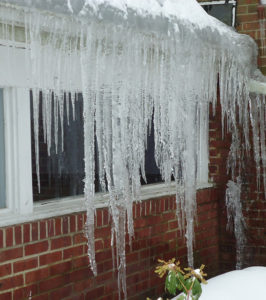-
For the people living in cold areas, the concept of ice dams is not foreign. Instead, every time after a heavy bout of snowfall, they may need to deal with the residual ice hanging from their roofs. An ice dam is residual ice that freezes at the roof’s edge and hangs there. If this ice is left to stay there, it can become so heavy that this might compromise the roof’s structural integrity as well as that of any other structure with which it hangs.

How are they formed?
When a roof warms over 32 degrees Fahrenheit, the ice accumulated warms up and moves towards the edge. These edges are usually cold, and when this ice gets to these freezing edges, it becomes solid once again. The ice on the roof often thaws due to relatively higher temperatures in the attic.In most cases, heat escapes through the ceilings and into the attic, where it heats the roof and causes it to leak. The temperature outside is below freezing point, but the heat escaping melts the ice, moving downwards towards the edges. These edges are not directly in contact with the attic and therefore stay frosty cold. As the thawed mass of ice reaches these edges, it freezes again and creates a rim of ice. The frozen rim of ice traps more incoming water and creates more hanging pieces of ice, building an ice dam.
Preventing Ice dam formation
Ice dams can be small and insignificant, but they can accumulate masses that compromise the roof’s integrity if left unchecked. The best way to keep these ice dams from forming is to keep the attic and roof cold.
To keep the roof and attic cold, you can follow the following steps:
Close up attic bypasses
Fill up the warm air leaks into the attic through gaps in drywall, unblocked walls and chimneys, access hatch cracks around plumbing pipes, light fixtures, and other ceiling penetrations, ensuring that these leaks are blocked insulated to prevent a higher temperature in the attic and roof.
Blocking these leaks is tiresome work that cannot be done in hot weather when your attic is steaming hot. Therefore, you should cover these crevices during a cold spell. A bonus to covering these heat outlets is saving energy and reducing your bills.
Determine the insulation level of your attic
The optimum R-value for a well-insulated attic is R-40; therefore, make sure that your attic’s insulation level is appropriate while you are fixing the leaks. Many building codes dictate a necessary 12 to 14 inches of fiberglass or cellulose and if your house has less than that, get it fixed, especially if you have had a history of ice dams in your roof.
Because they fill in more securely around barriers such as rafters, joists, and other structural members, cellulose and fiberglass that are blown in are often superior to those that are hand-placed. For this kind of work, it’s typically best to hire a professional rather than try to save money by doing it yourself. If you can’t seem to find a good deal, you can always hire a blower from a rental yard or home improvement store. Sometimes purchase of insulation includes free usage of the stores insulation blowing equipment.Add some vents to the roof and soffit.
The size for ventilation should be at least 1 square ft. per 300 sq. ft. of the ceiling area or the attic’s floor. The ventilation in the attic draws cold air in from the outside while giving out warm air, which ultimately cools down the loft and the roof.
Alternate rafter gaps can have 8 vents installed on the bottom of the soffit (overhang). Rebuilding the soffit is an excellent opportunity to add a continuous 2-1/2-inch-wide vent. Ventilate the peak with a continuous ridge of vents.
Add the standard square-shaped roof vents near the peak. The ventilation area should be equal to the size of soffit vents to provide ample ventilation.
It’s difficult to evaluate the venting in houses where aluminum has been installed over previously completed soffits. In some cases, you may need to remove multiple metal panels in order to examine the venting for ice damming.
Insulating the roof
Some types of roofs are difficult to vent, especially roofs with angled ceilings and no attic, skylights, flat roof dormers and low-slope roofs. You can use insulation to conserve the heat in such shelters.
If your house has an open attic, you need to insulate the attic floor. If you have a second story with the ceiling of the second story directly in contact with the roof, you can protect the rafter spaces.
These insulating techniques will keep the heat from rising to the roof and warming it up to a temperature that can thaw the ice on the roof.
Please keep in mind that as you make your house more insulated and airtight, you will have to keep a stricter check on the appliances that do not properly dump waste gases, like potentially deadly carbon monoxide, into your home, as there is now a limited outlet for air to expel these harmful gases.
Using prevention products
With heavy snowfall during the winters, you might get the ice dams forming anyway. Or your roof might be made in such a way that is friendlier for the formation of ice dams. That’s when secondary strategies come into play, and ice dam prevention products can be used.
A self-sealing underlayment, ice and water barrier attaches to the roof decking and protects it from the elements. Overlay a layer of this material 3 to 6 feet from the roof edge while replacing the roof. It’s more expensive to pull up an otherwise sound roof to install an ice-and-water barrier, but it’s less expensive if your roof is already in need of replacement. Ask your local building inspector how far you could run it up the ceiling in your location, as there is a construction code for it in most regions.
Raking the snow off
After a big snowfall, remove the snow from the roof using a rake to prevent it from melting and forming an ice dam on the roof’s edges. Single-story homes are the only ones that can benefit from this method, which is both time-consuming and tiresome. As using a rake on a ladder is not recommended, you cannot get to the top of a two-story house. In chilly weather, you’ll also have to deal with fragile shingles.
Getting rid of the snow before it melts and causes ice dams is one of the most used methods of preventing the said ice dams.
Installing heat cables
After exhausting all other options, installing heat wires can help avoid ice dams. High-resistance wires are used to construct heat cables, which are then plugged into an outside GFCI receptacle at the roof’s edge. They are appropriate for areas where ice dams develop often and cannot be prevented by any other means. You may need to find a means to get rid of the melted water to prevent it from freezing in the gutters and along the roof’s edge. To prevent ice buildup in the downspout, the heating cable must be routed within the downspout.
If you’ve already got an ice dam, what should you do?
If you know that you will have the imminent problem of ice dams once the winter arrives, you can take the following steps to combat the situation:
1. Clean the gutters
Keep all the drainage lines clean and remove the leaves that the Fall season left behind. Ensure that the downspouts are accurately functional, as the melted snow will have nowhere to go if these gutters are clogged.
2. Rake the roof properly
Though it is tiresome, make sure to rake the roof properly after every heavy snowfall. This way, even if some snow is left on the roof and it melts, it will still not dam up.
3. Use products to melt the ice
Calcium chloride is famous for instantly melting the ice. If you have ice dams forming, sprinkle this chemical over it, and the ice dams will come undone.
4. Chip off the ice
Chip it away as soon as you see the hanging ice by the edges. It is not required to chip the entirety of the ice dam off; you can merely remove enough to make a channel for the melted ice to move.
5. Hire professional help
Though this is the priciest of the options, it is the safest one for you. If you see ice dams forming and know that you will not be able to get rid of them efficiently yourself, look for professional help.Ice dams are a natural phenomenon and sometimes almost impossible to avoid when it snows incessantly. You will find yourself looking for ways to get rid of the icicles forming at the edges of your roof and compromising the integrity of the house’s structure, making it dangerous to stay in and feel safe.
For reliable, professional gutter cleaning and repair services. Call/Text us at 508-257-1832 or book online at http://www.guttercowboy.com/.
Send a text message to 508-257-1832 for a quick & free estimate
Or click here to book online
Send a text message to 508-257-1832 for a quick & free estimate now
Gutter Cowboy is a licensed and insured gutter cleaning and repair business serving Eastern Massachusetts
© 2017-2024 Gutter Cowboy. All rights reserved. Privacy Policy

